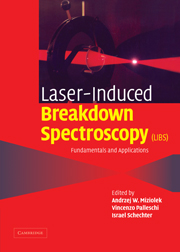Book contents
- Frontmatter
- Contents
- List of contributors
- Preface
- 1 History and fundamentals of LIBS
- 2 Plasma morphology
- 3 From sample to signal in laser-induced breakdown spectroscopy: a complex route to quantitative analysis
- 4 Laser-induced breakdown in gases: experiments and simulation
- 5 Analysis of aerosols by LIBS
- 6 Chemical imaging of surfaces using LIBS
- 7 Biomedical applications of LIBS
- 8 LIBS for the analysis of pharmaceutical materials
- 9 Cultural heritage applications of LIBS
- 10 Civilian and military environmental contamination studies using LIBS
- 11 Industrial applications of LIBS
- 12 Resonance-enhanced LIBS
- 13 Short-pulse LIBS: fundamentals and applications
- 14 High-speed, high-resolution LIBS using diode-pumped solid-state lasers
- 15 Laser-induced breakdown spectroscopy using sequential laser pulses
- 16 Micro LIBS technique
- 17 New spectral detectors for LIBS
- 18 Spark-induced breakdown spectroscopy: a description of an electrically generated LIBS-like process for elemental analysis of airborne particulates and solid samples
- Index
- References
6 - Chemical imaging of surfaces using LIBS
Published online by Cambridge University Press: 08 August 2009
- Frontmatter
- Contents
- List of contributors
- Preface
- 1 History and fundamentals of LIBS
- 2 Plasma morphology
- 3 From sample to signal in laser-induced breakdown spectroscopy: a complex route to quantitative analysis
- 4 Laser-induced breakdown in gases: experiments and simulation
- 5 Analysis of aerosols by LIBS
- 6 Chemical imaging of surfaces using LIBS
- 7 Biomedical applications of LIBS
- 8 LIBS for the analysis of pharmaceutical materials
- 9 Cultural heritage applications of LIBS
- 10 Civilian and military environmental contamination studies using LIBS
- 11 Industrial applications of LIBS
- 12 Resonance-enhanced LIBS
- 13 Short-pulse LIBS: fundamentals and applications
- 14 High-speed, high-resolution LIBS using diode-pumped solid-state lasers
- 15 Laser-induced breakdown spectroscopy using sequential laser pulses
- 16 Micro LIBS technique
- 17 New spectral detectors for LIBS
- 18 Spark-induced breakdown spectroscopy: a description of an electrically generated LIBS-like process for elemental analysis of airborne particulates and solid samples
- Index
- References
Summary
Introduction
The increasing demand of materials science for new and different kinds of information has resulted in radical changes in instrument capabilities during the past decade. Indeed, the central challenge to materials science of achieving an understanding of the continuum from the atomic level through nanomaterials to bulk properties of matter can be faced only with tools and methods of unprecedent analytical potential. Of particular relevance to this central problem has been the response given by chemical imaging methods. While a large number of imaging methods are available, the term chemical imaging refers to the information provided by some classes of imaging methods that can incorporate information on chemical identity to spatial dimensions. In this chapter we review the uses of LIBS as a chemical imaging tool. The several operating modes of LIBS imaging are presented and its properties of spatial resolution are discussed. The broad front of applications that has resulted from these properties is illustrated with examples taken from real world analytical situations.
It was not until relatively recent times that scientists came to understand the relationships between the structural elements of materials and their properties, empowering to a large degree the characteristics of materials, surfaces and interfaces [1]. To understand fully the surface of a solid material, analytical techniques are needed that not only distinguish the surface from the bulk of the solid, but also approaches are required that distinguish the properties of each [2].
- Type
- Chapter
- Information
- Laser Induced Breakdown Spectroscopy , pp. 254 - 281Publisher: Cambridge University PressPrint publication year: 2006



